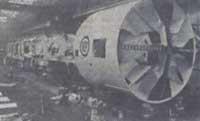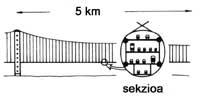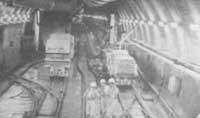On a channel for about 2,000?
1985/12/01 Hamer, Mick Iturria: Elhuyar aldizkaria

90 years later the works were retaken. In this period the Tunisians made 200 m towards France, until in 1974 the Labour party won the general elections and unilaterally paralyzed the work. Tony Crosland, Minister of Environment of that Government, later said that it was necessary to choose between the Concerto or the tunnel. In that government, Tony Benn, whose electoral constituency was Bristol, where the Concerto was to be built, convinced the Ministers to keep the start. The tunneling machine, worth > 550,000, was abandoned instead, covered with paraffin. However, the Environmental Cleaning Agency in charge of the oil machine failed. Saltwater did its job and the machine was sold as scrap in exchange for £20,000.
The heat of the project was thwarted by the French well before 1975. British interest rose in 1979 when the British Rail published plans to drill a single tunnel six meters in diameter. Sir Peter Parker, director of the British Rail, said this project would recycle the benefits of oil in North Dtt.
In March 1980, Norman Fouler, Minister of Transport, requested proposals. In January 1981 Kenneth Clarke, secretary of the minister, announced that a decision on the tunnel would be taken before the end of the year. In September of that same year the Prime Minister of Great Britain, Margaret Tatcher, and the new French Socialist President, François Mitterrand, finished their meeting of the first summit by proclaiming new studies on the Intermarine tunnel of La Mancha.
The only reason the tunnel was on the agenda was the need for the top to bear positive fruit

At the same time, the transport commission of the British House of Commons favored the tunnel instead of the bridge. In 1982 the Anglo-French study group also favored the tunnel, although the government spokesman had already spoken of the Maritime Union.
When the British government was studying this report, the news came that a rocket from the French during the Falkland War launched HMS Sheffield. The link of the art was sent to the fret. The problem was refiled, although the two governments wondered about the availability of private funding for the achievement of the four banks. The five, Banque Indosuez, Banque Nationale de Paris, Canal Lyonnais, Mindland Bank and National Westminster Bank, supported a double tunnel.
Recently, interest in the tunnel comes from Tatcher's visit last November. Bera and Mitterrand agreed on the design of the technical and financial specifications of the link within the commercial area of the European Economic Community district. Specifications have been published in early April. The promoters of the work have until 31 October to present the projects, according to the British minister of transport, the decision of end of year will be taken. With the running race five secularists of accreditation are back.
Project of the Channel Tunnel Group for a double tunnel for track, as it was abandoned in 1975 and very similar to that which was abandoned in 1883. It will be built according to the European standard of loading (height and width of the train), superior to the British Cargo Rule. However, only trains can travel through the tunnel according to the British railway standard.
The Euroroute project combines the laying tunnel with the car bridge and is similar to the one opened in 1964 at Chesapeake Bay in Maryland, USA. For the construction of the tunnels a deslinde or ditch will be made in the seabed, a base of cap will be placed and prefabricated foundation tubes will be placed. Pipes will be covered with rock to avoid fatal breaks. The project involves the construction of two nail artifacts. The bridges that connect the two vultures and their breakages can be viaducts or be supported by cables; the road traffic will make the way between the breeders down to the tunnel.

First competitor to cross the channel.
Proposal Eurobridge Studies Group: a
bridge of seven ocas sitting of 12 lanes of motorway to four heights on enclosed tube. The group says it would be willing to drill a 6-metre railway tunnel.
Length: bridges 35 km. would have them.
Crossing time: 22 minutes to 96 km/h.
Capacity: 6000 cars/hour in one direction.
Cost: £3800 million in 1983.
Construction time: five years.
Members: an informal group. Banking is "European Banking Company" and consulting engineers Pell, Frischmann and Partners.
The Eurobridge project proposes a hanging bridge, based on the 1973 proposal by Pell, Fris chamnn Partnes. Take a 12-lane highway to four heights. The design makes extensive use of new materials. On the highway floor will be made with sterkrato and steel sandwich. The stercrate is a reinforced polyester foundation. The conduit inside the motorway will be built in Superferrollo, the stainless foundation of the Shell house. ICI's Parafil fiber, six times lighter than steel and with the same strength, will be able, according to the designers, to keep the eyes of 5 km of the bridge seated.
Freeman Fox's design proposes a conventional eye bridge of 2 km. Along the same road runs the eye bridge between 550-850 m from Hellmut Hamberg. There is no serious plan for a rail bridge, not even for a perforated tunnel open to traffic, which would generate serious ventilation problems. In addition, it would be very expensive, as the cost of the tunnel increases depending on the square of the tunnel radius.
3 of the 8 existing projects in 1982 have been cancelled. Normally, by the end of the year, the five secularists will be high. Three barriers must be overcome: technical, financial and political.
The construction of the tunnel does not present many technical problems, as demonstrated by the victors in the period 1881-83. The test holes made in the Anglo-French study of 1964-65 indicated: Folkestone
That the lower crete of Shakespeare's cliff towards Sangatte, next to Calcus, was approximately waterproof. The geological problems of tunnel construction will be less than those caused by the recent long bridge of junction between two ugarte of southern Japan. It is possible that some of the main faults are in the way (the road had to be changed in 1973), but it is a very distant possibility.

Second competitor at the crossing of the channel.
Proposal Hellmut Homberg and
Partner: Hung bridge with 48 eyes wires. The maximum eye is 850 m.
Bridge: located 65 meters above sea level.
Length: 37 km.
Crossing time: 23 minutes at 96 km/h.
Capacity: 3000 cars/hour.
Cost: £ 2750 million approx.
Construction time: -
Vowels: Hellmut Hombertg has built bridges with several cables.
The most significant technical problem is ventilation. Although electric trains do not produce fumes, the tunnel must be kept fresh. According to the French study group Anglo, the service tunnel of the Channel Tunnel Group should be extended to 5.5 m so that air flow is necessary. This would mean a notable increase in cost, since in one step it cannot be built.
But bridges face more problems. The longest bridge in the world sitting is the so-called Humber Brigde, designed by Freeman Fox. It has a length of 1410 meters. Freeman Fox's design proposes 18 eye bridges of 2 kilometers in length, each eye of these would be 40% longer than that of Humber Bridge. Eyes 5 km from Eurobridge would be 3.5 times from Humber. The 850m eyes proposed by Humberg represent about half of the longest bridge sitting. According to the Anglo-French study group, the longest practical visual measurement is 2 km.
Long eyes make navigation less difficult in both construction and completion times. The English Channel is the busiest strait in the world. According to the French and British Government any structure on the Taint should be able to resist the shock of a giant oil tanker of 250,000 tns that navigates at a speed of 17 sea apilos, the largest ship that navigates the Canal.
Hamberg's advertising discards this problem. It proposes to prohibit the transport of oil and nuclear waste along the canal and limit the maximum size of vessels to 50,000 tons. Ships larger than those of oil or containers, which are also on long journeys, so access to Northern Scotland would not minimally charge the trip. Rotterdam's world oil market has no sympathy for Homberg's idea. Freeman Fox also believes there may be difficulties in meeting the impact scope. They are considering protecting their pillars with a water cushion. Eurobridge, which first suggested the criterion of the 17 strangulations, will protect its pillars with three Parafil rings connected with hydraulic pendulum.
The artificial ugarte of Euroroute, and the bridges that these and connect them to land, must face similar problems. The aforementioned Chesapeake Bay bridge has been several times off-site by collision. Sitting bridges should avoid domino breakage; if a cable breaks, the tension over the towers causes the other cable to explode leading to a succession of bellows. All these bridges, including the Euroroute, should be closed in very adverse times. Although ferries also have to close in adverse weather conditions, railway tunnels would be able to work all year round.

Third competitor to cross the channel.
Proposal
Linkintoeurope: 18 bridges with eyes of 2 kilometers. Only for road traffic and six lanes.
Length: 38 km.
Crossing time: 24 minutes at 96 km/h.
Capacity: 3000 hours of car.
Cost: 25 billion.
Construction time: - .
Members: behind is Freeman Fox Ltd, although Linkintoeurope is an independent company.
The biggest problem with Eurobigde is gaining confidence in Parafil materials. Parafil reduces the cost of wiring cables for a seated bridge and increases precipitation length. However, although the material has been used in the North Sea as a mast strap, it has not yet been used on a long sitting bridge.
With British insistence, all projects must be able to self-finance from private sources. Three projects have extraordinary financial support: Eurobridge, Eurorouite and Channel Tunnel Group. The profitability of any of these projects lies in the cost and subsequent income. However, if a project is financiable or not, it may be subject to cost overcoming or poor traffic forecasting.
The tunnel is the least likely to exceed expected costs. The Anglo-French study group considered that the cost of the tukel was around (1800) an error in 1982. On the other hand, the possibilities of the bridge, by tightening more technology, have more possibilities to exceed costs. The Group said about the Euroroute project "skeptical about forecasts" and the scheme "Face the greatest risks and difficulties".
Traffic forecasts are even more complicated. According to the Anglo-French study, the tunnel forecasts a low growth of 11 million. would take to Pasaia at the end of the century and bridge 12 million. Euroroute estimates that there will be 16 million passengers. The most likely forecast is 20, 27 and 32 million passengers, respectively.
As an invitation, the busiest stretch of the M1 motorway in the London area supports 21 million mobile cars and 400,000 buses, i.e. 45 million tickets. In the Bristol area, the Severn Bridge, linking Wales to England, uses 17 million trips.
Euroroute boasts 19 million tentacles from the end of the century. Eurobridge makes other forecasts: With 10 million tickets in 1991 and a 20% annual increase, at the end of the mine stands at 50 million. At the links of the car, the Mont Blanc Tunnel, the sickle provided has been 20% annually. In 1973, when forecasts were made for 1980 of the number of people crossing the canal, it was said that it would be about 47 million. Car traffic forecasts were quite wrong, while rail traffic forecasts were slighted (7.8 million people planned, 9 million trips) and air traffic forecasts were very disastrous.

Fourth competitor at the crossing of the channel.
Proposal
Eurorute: Tube tunnel submerged between two artificial tufts that will be located 8 Km from the coasts of France and England. The tunnel would support both road and rail traffic, with two tracks and four lanes. The two artificial traps would be connected to the coast by bridges, in the case of road traffic. The railway would continue in a tunnel.
Length: 36 Km.
Crossing time: 23 minutes to 96 Km/h. Speed of trains m xíxo 160 Km/h.
Capacity: 2000 cars/hour in one direction. Trains could run every 2 minutes.
Cost: £4 billion in 1983.
Construction time: five years.
Members: Alsthom-Atlantique, Banque Societé Generale, British Shipbuilders, British Steel Corporation, Fairclough Construction Group, Grands Travaux de Marselle, John Howard Group and Trafalgar House.
If the air passages of the ltxadones were 30 million, they barely reached 20 million. The rise of rail traffic is perhaps surprising, considering that the journey from London to Paris is now longer than before World War I.
Funding channel linking will be a risky business. The political barrier is more subtle. Except for Euroraute, the rest of the competitors are British. In February Channel Tunnel Group, Sir Nicholas Henderson, former French ambassador and very close to Thatcher -engadik in the South Atlantic War, embarks at the Natioinal Westminster Bank. In this project, very political, he knows what will be more important than any technical consideration.
Agents will also have to cope with pressure from ferry companies and port managers. The company has announced that if the link was already accepted it would be the end of the ferries crossing the channel. The impact is not very likely, and in this sense, shops without taxes, which will not exist in the bond, will have much to say. However, the ferries must be more responsible with the road bridge than with the tunnel that would still leave enough surface traffic.
On the other hand, governments should also decide whether the connection should be road and rail or both.
Operators claim that traffic is done on a four-fifths road, so the answer is road connection. Their numbers are misleading because they include many short trips. The railways cover much of the long distance market and the Strait of La Mancha covers a minimum journey of 40 km. Normally, half of the passageways that cross the canal circulate by car or bus, the rest by train (or on foot). The decisive answer to this problem will come possible from the hand of the French government, which has insisted on the railway.

Fifth rival to cross the channel.
Proposal The Channel Tunnel
Group: Two railway tunnels dug in crete and 40 meters under seabed. Each tunnel has a diameter of 7 m. Among them would be a 4.5 m diameter service tunnel. Road traffic would be transported by train.
Length: 47 Km, 37 under the sea.
Crossing time: 'The maximum speed of the trains would be 160 Km/h.
Capacity. More than 7000 cars/hour in one direction.
Cost: £1,900 in 1983.
Construction time: six years.
Members: Balfour Beatty, Costain, National Westminster Bank, Tarmac, Taylor Woodrow and Wimpey.
Any project that prevents navigation through the canal, and this implies any other purpose outside the tunnel, involves negotiating with the International Maritime Organization the accidental change of the navigation ropes. If the bridge is chosen, the governments of France and Britain would drive the organization, but this negotiation could prove sterile.
If agents are going to deal, governments will have to respond. The failed bridge gives two solutions to governments: complete or deteriorate it. Any option will be expensive. If the tunnel industry fails, governments have a cheap option to flood the tunnel.
The initial election of the government is simple, to go above or below. Official sources have almost always favored the tunnel. The bridge projects carry the risk of showing that they are impossible after two years of testing. The tunnel can offer the capacity of the major bridge at almost an average price. For this problem, the report of the five banks indicates with the tunnel, which is the only technically acceptable and financially viable project.
For when?

Gai honi buruzko eduki gehiago
Elhuyarrek garatutako teknologia





